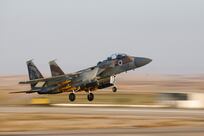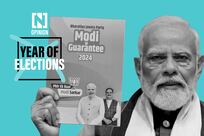Palestinian artists often find the political inescapable. It takes no stretch of the imagination to understand why. In the case of Oussama Diab, however, the narrowly defined "political" has been broadened to encompass far more than a claustrophobic awareness of his own nationality. "At the beginning of my career," Diab said last week at Dubai's Ayyam Gallery the day after the opening of his solo show there, "I tried to approach the Palestinian problem but eventually I moved on to deal with larger political issues that affect all of humanity. After all, I thought, aren't Palestinians a part of humanity?" The Syrian-born Diab says that he feels equally Palestinian and Syrian, his parents having emigrated at the time of the Nakba. His recent paintings, however, are influenced by issues that go far beyond the events that led to his Syrian passport. Dominating the show at Ayyam in Dubai is a large and colourful painting called The New Monalisa in which he places a gas mask on a graffiti-esque version of the icon in the midst of scrawled anti-nuke, 9/11 and other symbols.
"This is what we all have to be aware of," he said in reference to this and a similar rendition of Munch's The Scream. "No one can escape these things. Not anywhere. It affects everyone and that includes the art world, as well." The casual observer may disagree but no art exists outside of the political spectrum. All art is created within a political environment that finds itself one way or another into the finished product. "Sometimes I try to make a direct political statement," Diab continued. "Sometimes I try to be more subtle and let the viewer find it." Then, he gestures across the gallery to a triptych of faces whose eyes are the only defining characteristics. "Yes, even those. That's my face." Ultimately, however, Diab resorts to paraphrasing Karl Marx. "Politics is a bitch," he concluded. There is a lot going on in Diab's paintings and they sometimes straddle the line between the figurative and the abstract with a hint, albeit seemingly quite studied, of the naive roots of street art. The gallery's promotional material makes much of his similarity with the late New York graffiti artist Jean Michel Basquiat. There are similarities between the two in the sometimes cartoonish distortion of the human form set within a busy canvas peppered with symbols. There are also similarities with some of Marc Chagall's canvasses with their figures seemingly swimming through the air. As one visitor to the gallery put it, "[Diab's art] is like Basquiat and Chagall had a baby." Diab shrugs off the comparisons and generally disavows the notion of direct influence. "It would be an honour to be influenced by Chagall and to be compared to him," he said, "but the truth is that I have studied and seen all of the legends and I have tried to make my own art."
One of the kind of value-added features of the exhibition is a video of Diab doing just that: making his own art. The video is speeded up significantly so the viewer can watch the artist go from blank canvas to completed painting, in the process painting in figures and then painting over them, essentially deleting them from the work. About the process of painting, Diab echoes a writer facing a blank page in a typewriter or a flashing cursor on a blank screen. "I absolutely have a fear of a blank canvas," he said. "For the first few minutes, at least, I don't how to start. But once I start doing it, that disappears and I am completely into the feeling. The fear transforms itself into a love relationship." Ayyam, which operates galleries in Dubai, Beirut and Damascus that represent primarily works from Levant artists, is betting that love relationship will spread to the buying public, as well. Hisham Samawi of Ayyam said that its Damascus branch showed Diab's work privately to some of its regular collectors and the response was very positive. That resulted in Diab's solo show in Damascus in November and the current one in Dubai. Diab seems relaxed with the attention and unfazed by the appearance of journalists waiting to talk to him. He said that he feels obligated to embody a certain human warmth that comes with the status granted artists in Damascus. He is happy to talk and happy to ask questions but he seems just as happy not to talk too much about the artwork itself. "I don't like to talk to much about the individual paintings," he said, "because if you overanalyze anything, you kill it...If someone invites you to listen to Beethoven's Ninth Symphony, you can only ask later what you feel about it upon reflection. Art is the same."




